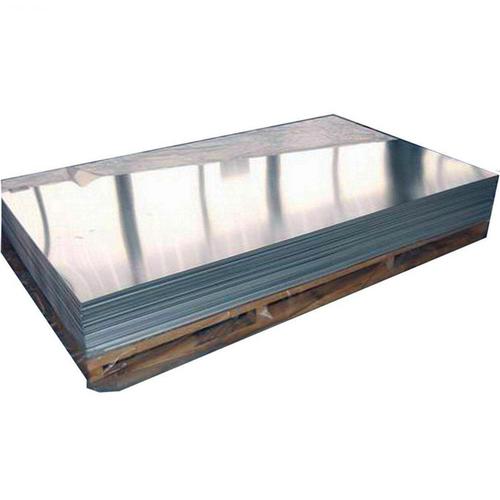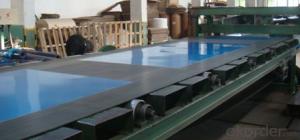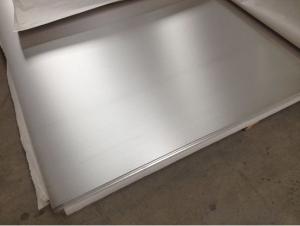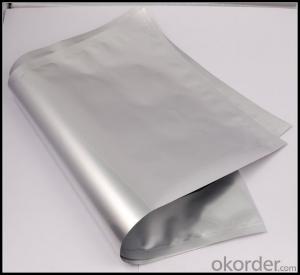Lightweight Aluminum Sheet for Automobile Skin 5052-H32 5754 6061 7075
- Loading Port:
- QINGDAO
- Payment Terms:
- TT OR LC
- Min Order Qty:
- 1 T
- Supply Capability:
- 200 T/month
OKorder Service Pledge
OKorder Financial Service
You Might Also Like
Specification
With the continuous development of automobile lightweight technology, automobile body aluminum sheet has become one of the indispensable key materials in the automobile manufacturing industry. Its characteristics and applications have an important impact on the performance, safety and fuel economy of the automobile.
Automobile body aluminum sheet mainly includes the following types:
5000 series: such as 5052, 5754, etc. These alloys have medium yield strength and tensile strength, good corrosion resistance and processing performance, and are widely used in automobile inner panels, doors, engine hoods and other parts.
6000 series: such as 6016, 6061, etc. These alloys are heat-treatable aluminum alloys with high strength, good formability and corrosion resistance. They are often used in automobile chassis, suspension components and other structural parts.
7000 series: such as 7075, etc. These alloys have excellent strength and toughness, but relatively poor formability, and are usually used for parts with extremely high strength requirements, such as racing car bodies.
Specifications of automotive aluminum sheet:
| Alloy | 5052, 5754, 6061, 6016, 7075, etc |
| Temper | F, O, H12, H14, H16, H18, H19, H22, H24, H26, H28, H32, H34, H36, H38, H111, H112, H114, etc |
| Thickness (mm) | 0.1-500 |
| Width (mm) | 20-2650 |
| Length (mm) | 500-16000 |
| Other | Can be processed by painting, embossing, cutting, patterning, striping, etc. |

Advantages of automotive aluminum sheet:
1. Lightweight: Aluminum alloy materials are light in weight, which helps to reduce the overall weight of the car and improve fuel economy and driving performance.
2. High strength: After proper process treatment, the aluminum sheet can obtain high strength to ensure that the car body maintains structural strength.
3. Good corrosion resistance: Aluminum alloy materials have excellent corrosion resistance and extend the service life of the car.
4. Good formability: Aluminum plates are easy to process into various shapes to meet the design requirements of automobiles.
5. Strong recyclability: Aluminum plates have high recycling value and meet environmental protection requirements.



- Q: How do you prevent scratches during transportation of aluminum sheets?
- To prevent scratches during transportation of aluminum sheets, there are several measures that can be taken: 1. Proper packaging: Ensure that the aluminum sheets are packaged securely in appropriate materials such as bubble wrap, foam, or cardboard to provide cushioning and protection from external impacts. 2. Use protective layers: Place protective layers such as paper or plastic film between individual sheets to prevent direct contact and minimize chances of scratching. 3. Secure stacking: When loading aluminum sheets onto transportation vehicles, ensure they are stacked securely to prevent any movement or shifting during transit. This can be achieved by using appropriate strapping or palletizing techniques. 4. Handling with care: Train personnel involved in the transportation process to handle the aluminum sheets with care, avoiding dragging or sliding them against rough surfaces that may cause scratches. 5. Avoid contact with sharp objects: Make sure that the aluminum sheets are not in contact with sharp objects or edges that may cause scratches. This can be achieved by keeping them away from other materials or using protective covers. 6. Regular inspection: Regularly inspect the aluminum sheets during transportation to identify any potential scratches or damages. If any are found, immediate action should be taken to prevent further damage. By following these preventive measures, the chances of scratches occurring during the transportation of aluminum sheets can be significantly reduced, ensuring that the sheets are delivered in optimal condition to their destination.
- Q: what’s the difference of activated aluminum and aluminum sheet?
- contain more water and activated
- Q: how to produce aluminium sheet circle?
- As for the process, you can use punch.. as for professional machines, for example, stationary press in open type, mechanical press/ single-point press. The material you say is neither big nor small, blanking…(cutting them into sheet circle you want) you can add an uncoiling if it’s coil stock: open-type inclinable press, four-point press,ect. It’s not certainly accurate) punch, oil press, double , four-column hydraulic (oil) press,etc. it needs about 315T,(estimated value, closed type single, blank material cutting (cutting into square ) 2, it contains sheet metal forming technology, crank press: 1: straight side two : 1, but the components you said is simple, only two steps.
- Q: Can 101 aluminum sheets be anodized?
- Yes, 101 aluminum sheets can be anodized.
- Q: which has greater density 5 kg of lead or 10 kg of aluminum
- The density of ANY amount of lead is greater than the density of ANY amount of aluminum. So even if we have a tiny speck of lead, and a truckload of Aluminum the lead still has greater density. The density of a substance does not depend on how much of it we have. One drop of water have a density of 1g/cm^3 and an ocean of water have exactly the same density of 1g/cm^3. The only difference is that the drop of water has less mass than the ocean, hence it would be easier to fetch; and the drop also has less volume hence it takes up less space.
- Q: What are the advantages of using aluminum sheets in the transportation industry?
- There are several advantages of using aluminum sheets in the transportation industry. Firstly, aluminum is a lightweight material, making it ideal for use in vehicles as it helps reduce fuel consumption and increase overall efficiency. This is particularly important for industries such as aviation and automotive, where weight reduction is a key factor in improving performance. Secondly, aluminum has excellent corrosion resistance properties. This is crucial in the transportation industry, where vehicles are exposed to various environmental conditions such as rain, snow, and road salt. Using aluminum sheets helps to extend the lifespan of vehicles and reduces maintenance costs associated with corrosion-related issues. Additionally, aluminum is highly recyclable, making it a more sustainable choice compared to other materials. The transportation industry is increasingly focusing on sustainability, and the use of aluminum sheets aligns with these goals. Recycling aluminum requires significantly less energy compared to producing it from raw materials, leading to reduced carbon emissions and energy consumption. Moreover, aluminum offers excellent formability and versatility. It can be easily molded into various shapes and sizes, allowing manufacturers to design lightweight yet strong structures. This flexibility in design enables the production of more aerodynamic vehicles, leading to improved fuel efficiency. Lastly, aluminum sheets have high strength-to-weight ratio, meaning they can provide the required strength while still being lightweight. This property makes aluminum an ideal material for applications that require strength and durability, such as vehicle bodies, chassis, and structural components. Overall, the advantages of using aluminum sheets in the transportation industry include weight reduction, corrosion resistance, sustainability, formability, versatility, and high strength-to-weight ratio. These benefits contribute to improved performance, fuel efficiency, and durability of vehicles, making aluminum an excellent choice for various transportation applications.
- Q: the coil is wrapped around the aluminium pipe will it effect the efficiency of the coil gun ?
- Yes, it absorbs most magnetic force generate by coil and turns it into useless current .
- Q: This question asks for a comparison between the benefits and drawbacks of utilizing products made from recycled aluminum.
- <p>Advantages of using recycled aluminum products include reduced energy consumption, lower greenhouse gas emissions, and a decrease in the need for raw material extraction. It also promotes waste reduction and supports a circular economy. Disadvantages might include potential quality concerns, as recycled aluminum might not always meet the same strength and durability standards as new aluminum. Additionally, there can be higher initial costs associated with recycling processes and the need for advanced sorting and processing technologies.</p>
- Q: Can aluminum sheet be used for reflective surfaces?
- Indeed, reflective surfaces can be achieved with the use of aluminum sheet. Renowned for its exceptional reflectivity, aluminum is widely preferred for an array of applications that call for reflective surfaces. By skillfully polishing aluminum sheets, they can attain a remarkable luster, enabling them to reflect light and produce a mirror-like effect. Consequently, they prove to be the perfect choice for applications such as lighting fixture reflectors, solar panels, mirrors, and decorative purposes. Moreover, owing to its reflective properties, aluminum is an ideal material for situations necessitating heat reflection, including thermal insulation and roofing materials. In summary, aluminum sheets offer versatility and effectiveness when it comes to generating reflective surfaces.
- Q: Can aluminum sheets be used in construction?
- Yes, aluminum sheets can be used in construction. Aluminum is a versatile and lightweight material that possesses several beneficial properties for construction purposes. It is corrosion-resistant, making it suitable for both indoor and outdoor applications. Aluminum sheets also have high strength-to-weight ratio, meaning they offer strength and durability while remaining relatively lightweight, which can be advantageous in construction projects where weight is a concern. Additionally, aluminum is non-toxic and highly recyclable, making it an environmentally friendly choice. These factors, combined with its aesthetic appeal and ease of fabrication, make aluminum sheets a popular choice for various construction applications such as roofing, cladding, wall panels, window frames, and more.
Send your message to us
Lightweight Aluminum Sheet for Automobile Skin 5052-H32 5754 6061 7075
- Loading Port:
- QINGDAO
- Payment Terms:
- TT OR LC
- Min Order Qty:
- 1 T
- Supply Capability:
- 200 T/month
OKorder Service Pledge
OKorder Financial Service
Similar products
Hot products
Hot Searches
Related keywords






























